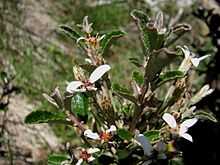Olearia myrsinoides
| Olearia myrsinoides | |
|---|---|
 | |
| Olearia myrsinoides Alpine National Park, Victoria | |
| Scientific classification | |
| Kingdom: | Plantae |
| (unranked): | Angiosperms |
| (unranked): | Eudicots |
| (unranked): | Asterids |
| Order: | Asterales |
| Family: | Asteraceae |
| Tribe: | Astereae |
| Genus: | Olearia |
| Species: | O. myrsinoides |
| Binomial name | |
| Olearia myrsinoides (Labill.) F.Muell. ex Benth.[1] | |
| Synonyms | |
|
Aster myrsinoides Labill. | |
Olearia myrsinoides, commonly known as Silky Daisy-bush, is a species of flowering plant in the family Asteraceae.[2] It is a shrub to 1.5 metres high with toothed leaves. These are dark green above and tomentose underneath.[2] The flowerheads have 2 to 4 white ray florets and 3 to 4 pale yellow or violet disc florets.[2] These appear between November and March in the species native range. The species was formally described in 1806 in Novae Hollandiae Plantarum Specimen by French naturalist Jacques Labillardière who named it Aster myrsinoides.[1] In 1867 it was transferred to the genus Olearia in Flora Australiensis.[1]
It occurs in woodland, grassland, and swampy areas in New South Wales (south of McPherson Range), Victoria, and Tasmania.[2]
References
- ↑ 1.0 1.1 1.2 "Olearia myrsinoides". Australian Plant Name Index (APNI), IBIS database. Centre for Plant Biodiversity Research, Australian Government, Canberra. Retrieved 30 December 2012.
- ↑ 2.0 2.1 2.2 2.3 Lander, N.S. "Olearia myrsinoides". PlantNET - New South Wales Flora Online. Royal Botanic Gardens & Domain Trust, Sydney Australia. Retrieved 30 December 2012.